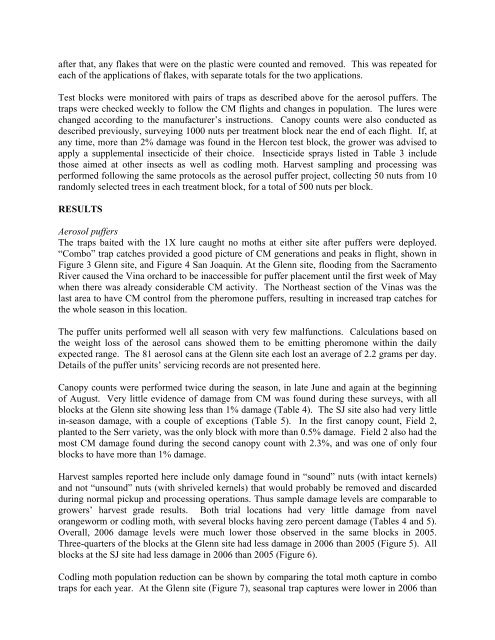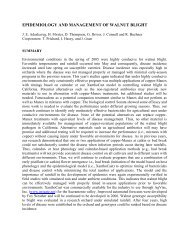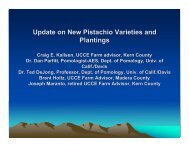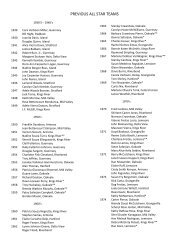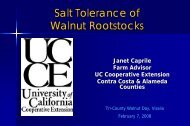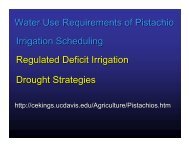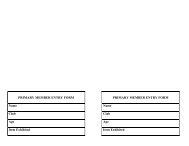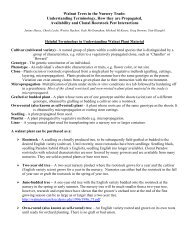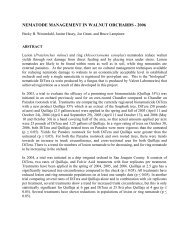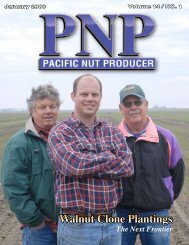using aerosol pheromone âpuffersâ - Walnut Research Reports
using aerosol pheromone âpuffersâ - Walnut Research Reports
using aerosol pheromone âpuffersâ - Walnut Research Reports
Create successful ePaper yourself
Turn your PDF publications into a flip-book with our unique Google optimized e-Paper software.
after that, any flakes that were on the plastic were counted and removed. This was repeated for<br />
each of the applications of flakes, with separate totals for the two applications.<br />
Test blocks were monitored with pairs of traps as described above for the <strong>aerosol</strong> puffers. The<br />
traps were checked weekly to follow the CM flights and changes in population. The lures were<br />
changed according to the manufacturer’s instructions. Canopy counts were also conducted as<br />
described previously, surveying 1000 nuts per treatment block near the end of each flight. If, at<br />
any time, more than 2% damage was found in the Hercon test block, the grower was advised to<br />
apply a supplemental insecticide of their choice. Insecticide sprays listed in Table 3 include<br />
those aimed at other insects as well as codling moth. Harvest sampling and processing was<br />
performed following the same protocols as the <strong>aerosol</strong> puffer project, collecting 50 nuts from 10<br />
randomly selected trees in each treatment block, for a total of 500 nuts per block.<br />
RESULTS<br />
Aerosol puffers<br />
The traps baited with the 1X lure caught no moths at either site after puffers were deployed.<br />
“Combo” trap catches provided a good picture of CM generations and peaks in flight, shown in<br />
Figure 3 Glenn site, and Figure 4 San Joaquin. At the Glenn site, flooding from the Sacramento<br />
River caused the Vina orchard to be inaccessible for puffer placement until the first week of May<br />
when there was already considerable CM activity. The Northeast section of the Vinas was the<br />
last area to have CM control from the <strong>pheromone</strong> puffers, resulting in increased trap catches for<br />
the whole season in this location.<br />
The puffer units performed well all season with very few malfunctions. Calculations based on<br />
the weight loss of the <strong>aerosol</strong> cans showed them to be emitting <strong>pheromone</strong> within the daily<br />
expected range. The 81 <strong>aerosol</strong> cans at the Glenn site each lost an average of 2.2 grams per day.<br />
Details of the puffer units’ servicing records are not presented here.<br />
Canopy counts were performed twice during the season, in late June and again at the beginning<br />
of August. Very little evidence of damage from CM was found during these surveys, with all<br />
blocks at the Glenn site showing less than 1% damage (Table 4). The SJ site also had very little<br />
in-season damage, with a couple of exceptions (Table 5). In the first canopy count, Field 2,<br />
planted to the Serr variety, was the only block with more than 0.5% damage. Field 2 also had the<br />
most CM damage found during the second canopy count with 2.3%, and was one of only four<br />
blocks to have more than 1% damage.<br />
Harvest samples reported here include only damage found in “sound” nuts (with intact kernels)<br />
and not “unsound” nuts (with shriveled kernels) that would probably be removed and discarded<br />
during normal pickup and processing operations. Thus sample damage levels are comparable to<br />
growers’ harvest grade results. Both trial locations had very little damage from navel<br />
orangeworm or codling moth, with several blocks having zero percent damage (Tables 4 and 5).<br />
Overall, 2006 damage levels were much lower those observed in the same blocks in 2005.<br />
Three-quarters of the blocks at the Glenn site had less damage in 2006 than 2005 (Figure 5). All<br />
blocks at the SJ site had less damage in 2006 than 2005 (Figure 6).<br />
Codling moth population reduction can be shown by comparing the total moth capture in combo<br />
traps for each year. At the Glenn site (Figure 7), seasonal trap captures were lower in 2006 than


